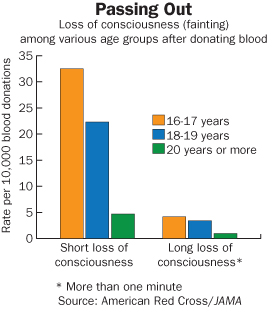Donor dilemma
Young who give blood faint more than older donors
Minors who donate blood are more likely to faint than adults and more likely to get injured from these blackouts. While several factors might contribute to passing out, low body weight seems to play a role, two new studies show.

People age 16 can donate blood in 24 U.S. states, and 17-year-olds can donate nearly anywhere. Typically a person must weigh at least 110 pounds and meet other basic health specifications to donate blood. People age 19 and under provide more than 14 percent of the donated blood units for the American Red Cross.
In the May 21 Journal of the American Medical Association, scientists at the American Red Cross evaluated adverse reactions among blood donors at nine sites across the country. Their analysis included more than 145,000 blood donations by minors age 16 or 17, plus more than 100,000 from people age 18 or 19 and more than 1 million donations by people age 20 or older.
The youngest donors were nearly seven times as likely to faint as were donors age 20 or older and 14 times as likely to be injured in falls.
In the other study, researchers at the Blood Systems Research Institute in San Francisco and United Blood Services in ScottsdaleAriz., analyzed fainting episodes arising from roughly 400,000 blood donations. They found that people age 17 and 18 years were significantly more likely to faint than donors over age 25. That report appeared online May 14 in Transfusion.
Body size can be used to estimate a person’s blood volume. Those who fainted or became light-headed were three times as likely to have low blood volume as those who didn’t, says Brian Custer, an epidemiologist at the Blood Systems Research Institute.
In both studies women and first-time donors were more likely to faint than men and experienced donors. But it’s unclear why young people or slight people pass out more easily, says Custer, who coauthored the study in Transfusion.
Light-headedness and fainting result from a temporary shortage of blood flow to the brain. The body might sense rapid loss of blood and engage an automatic shutdown reflex in some people, says Anne Eder, a clinical pathologist at the Red Cross in Washington, D.C. There’s probably a psychological component, too, she says.
The actual number of people who passed out after donating blood in these studies was small — only in the hundreds. Custer says the vast majority of people who faint do so while still in the chair or afterward in the waiting room while having the traditional juice and cookies. But fainting carries high risk if it occurs later, especially if a donor is driving a car. He and his colleagues are now investigating alternative strategies to limit fainting. Keeping young or slight donors in the waiting room longer might limit accidents, Custer says. He and his colleagues are also exploring the idea of taking slightly less blood from smaller people — possibly 450 milliliters instead of the usual 500 milliliters that constitutes a standard unit of blood.
Meanwhile, blood collection organizations have become increasingly dependent on young donors. “Donor demographics are changing,” says Eder, who coauthored the JAMA study. “As the proportion of the population over age 50 that was highly committed to blood donation gets older, their blood donation rates drop off.”
“We certainly don’t want to scare donors away,” she says. Getting a good night’s sleep beforehand, eating a nutritious meal and drinking a few glasses of water all go a long way to minimize fainting risk, Eder says.







